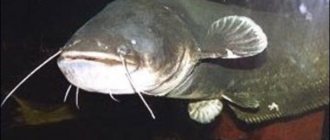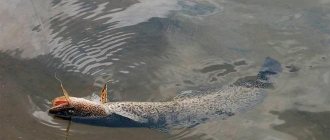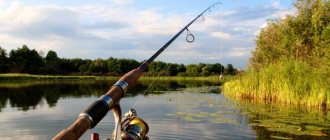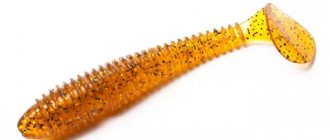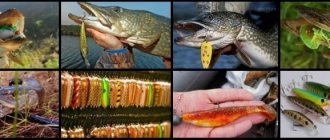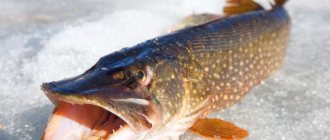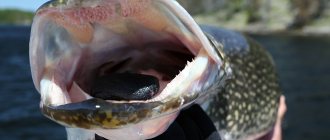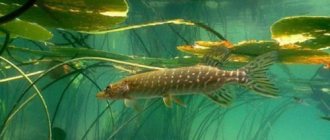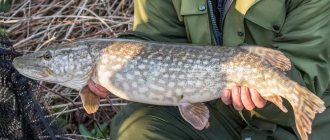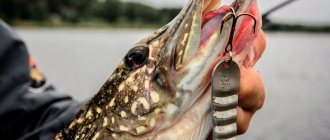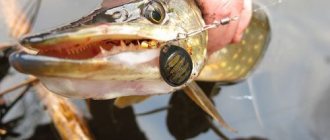The autumn pike bite in most regions of our country begins in mid-August and continues until late autumn. Its onset coincides with a cold snap and a decrease in water temperature in reservoirs. It is worth noting that pike biting activity is not always associated with good autumn sunny weather. It often happens that the weather is cloudy and there is light rain, but you can enjoy great fishing and an excellent catch.
The ideal condition for excellent lure fishing for pike is the absence of other anglers nearby, because it is a very shy fish. Professional fishermen are very interested in autumn fishing for pike with spoons, as the predator, having gained weight over the summer, becomes very persistent and wages an energetic fight.
Best fishing time
Early morning is the ideal time to catch pike with a spoon. The white fish of our reservoirs begin to emerge from hibernation, and, accordingly, predators begin to hunt for them. At the same time, visibility is not good enough to distinguish the spoon from the fry. Later, when the sun rises higher, the fishing activity drops on artificial baits. By noon, in sunny weather, biting activity becomes zero. On a clear day, around 5-6 p.m., the evening bite begins, and the darker it gets, the better the bite. Pike is a diurnal predator; its last active bites will be before sunset.
Why use big baits?
Why is such a seemingly inflated “load capacity” of a spinning rod and the size of a spinner or twister needed? The fact is that autumn fish no longer tends to the grassy shallows, where in the summer there was a lot of food and warmth for silvery fish and, accordingly, a fertile food supply for all predators. No, with the colder weather, all aquatic creatures now go to deep places, where most fish from the carp family will remain in wintering pits until spring. And only roach, silver bream, and bream will actively feed, and even then with periods of extinction of the bite and with some improvements in clear weather and even pressure.
Choosing a spinner
The most common bait for catching pike in the fall is a metal spoon. At this moment there is a very wide variety of spinners. Sometimes experienced fishermen cannot give an exact answer on which lure to choose. Many anglers intuitively choose spoons, since pike is an unpredictable fish. Some people believe that a bright lure will attract the attention of pike faster. But there are exceptions here too. When fishing for pike in mid-water, it is better to take a dark-colored lure. And for deep casting it is better to have brighter spinners. Spoons for catching pike are divided into oscillating and rotating types.
We also recommend reading:
Model range of Salmo wobblers and Salmo Hornet catalog Spinner for pike - 10 best and how to make it yourself? Features of catching pike on girders in winter and summer Attractant for predatory fish: bait for pike perch, pike perch
Silicone lures for pike fishing
This type of bait brought about a revolution and brought recreational fishing to a completely different level. The use of soft material made it possible to make the bait play more realistic, which resulted in a large number of bites.
In addition, silicone baits break all records in terms of their variety: vibrotails, twisters, leeches, worms, cuttlefish, mice, toads, crustaceans, etc. All of them, in the hands of an experienced spinning fisherman, turn into baits that very plausibly imitate living creatures, and this does not leave without the attention of a predator. The wiring technique can be the same as for “spinners” and “oscillators”, but when using “silicone” spinning rods, spinners use stepped wiring.
You can learn about wiring techniques on the Internet by watching the corresponding video. And yet, sometimes you have to experimentally find the wiring for a particular bait. Fishing is a boundless field for experimentation, where you can find and lose, meet success or failure.
Oscillating spoon
In general terms, it is a metal plate that imitates the body of a small fish. It has a convex shape on one side and a concave shape on the other, which causes it to oscillate from side to side, imitating the natural movement of a fish. To catch pike, it is better to use a medium or large size spoon, since the predator ignores a small model. When fishing at great depths, a heavy and narrow spoon has proven itself well. But light and wide are perfect for shallow water. This same spoon is perfect for fishing in clear waters. It must be taken into account that the retrieval must be done very slowly so that the spoon swings smoothly from side to side. Otherwise, the oscillating spoon will begin to rotate, thereby scaring away the predator.
Features of equipment for pike
Any fishing tackle for pike fishing must be reliable. For spinning, if you do not plan to take a trophy specimen, it is better to use braided fishing line with a thickness of 0.15-0.2 mm. For fishing with a donk, a girder or a mug, a monofilament with a cross-section of 0.25-0.3 mm is more suitable.
The use of a steel or tungsten leader is also important. Not a single fish in our latitudes has such teeth as pike. Cutting through a 0.3 mm thick fishing line is a piece of cake. Many novice fishermen lose their catch without even seeing it, precisely because of neglecting this condition.
Spinner
This spoon consists of: a plate with an attached hook or tee at the tip and a rotating petal. Having a medium size, this spoon is very effective for catching pike. The petal, with its rotation, creates vibration in the water, which attracts the attention of the predator.
The ideal size of a spinner, or “spinner” as it is called, for pike is No. 3–6. The main point in the “spinner” is the shape of the petal, which affects the frequency and power of rotation, speed and wiring resistance. The petal of the “Long” model has a shape identical to a willow leaf. Rotating, the angle of deflection of the petal reaches 30 degrees, which provides easy movement of the bait. This type of bait has proven itself well at great depths, as well as when fishing against the current.
A spinner equipped with a Comet model petal is often called universal. Due to its round shape, when the petal rotates, the angle of deflection, which reaches 45 degrees, forms resistance of average power. This type of lure for pike has proven itself well both in strong currents and in standing water.
The petal of the Aglia model has an almost round shape. The deflection angle during fishing reaches 60–70 degrees and creates maximum resistance, that is, it makes the fishing leisurely, excellent for pike fishing in still water. The Aglia spinner is excellent for catching both passive and active pike.
Autumn lure of pike
Autumn is the best time for pike fishing. As water and air temperatures drop, pike become more active. The first frosts and low atmospheric pressure are ideal conditions for pike hunting. During most of October, pike are extremely active, they can be caught in all layers of water, so the choice of baits that can be used is quite wide.
Wobblers and spinners
When fishing is carried out in shallow standing water or in the upper layer of a deeper reservoir, preference is given to wobblers with shallow depth and light “spinners”. After the first frost, when algae from the surface of the water fall to the bottom, these baits are also effective due to their greater maneuverability when retrieving.
Any snagging on the grass and dragging of the grass through the water frightens the pike nearby, and it changes its position. This means that the angler must now look elsewhere for a good position.
It is also important for the angler to be able to accurately cast the bait out of the window among the grass the first time. Fish may suddenly attack your bait immediately after splashdown, and you must be ready to react immediately.
Pike is caught in the fall using large, slow lures...
Spinner in September and October
An excellent time for pike fishing is September and early October. This period is the best time to use a spinner. The picture when a pike (especially a large one standing in shallow water) starts after the offered bait, leaving behind a wave-like trail, gives exceptional pleasure to any angler. At this time, predators are in the best shape, so both the one who catches and the one who is hooked can expect a long and exhausting fight.
Fishing for a big pike
Immediately after a strong blow to the spoon, a large pike rushes into snags or into the grass, and if braid is used, then sometimes hooking is almost not required. The predator rushes towards the fisherman (if fishing is done from a boat) in order to pass under the boat and tangle the fishing line around the lowered anchor. All this suggests that she is a stubborn and cunning fighter who knows how to take advantage of any mistake and haste of the one who is trying to catch her.
Large pike use every opportunity to free themselves from the spoon. She will shake her head wildly, trying to break the line. To prevent this from happening, you need to open the arm of the reel - this will allow the fish, still full of strength, to swim some distance, and then you can gradually tire it out and bring it towards you, trying not to allow it to go into the snags.
Big pike in the water - fishing
Flashing from a boat
Autumn allows you to explore the reservoir from all sorts of positions, since fish can be caught both in depth and in shallow water near flooded bushes and trees, and near the edge of the grass.
When fishing from a boat, the lure must be held parallel to the shore, then it will pass near the pike lying in ambush in the seaweed or reeds and waiting for its prey. The predator attacks the lure held in this way, because small fish also swim along the shore in the same way.
If the fisherman throws the bait at a right angle to the shore, it often turns out that it goes straight into the mouth of the pike, which is standing just a few meters away from him. Such a movement is unnatural for small fish, so you should not expect an attack on the spoon.
Such situations indicate that fishing from a boat allows you to cover more space from different angles. If you don't have a boat, you can enter the water (in waders or waders, of course) in front of the reeds or water lilies to get into an advantageous position for casting a spoon along the shore.
Mid autumn
You should not miss a single place, even one that at first glance does not promise much. Often it is in such places that good specimens can be caught, especially in cases where this place has not been disturbed before.
In mid-autumn, pike are active throughout the day. If the weather is cloudy, you can catch large pike at noon, which means that there is no particular need to wake up and go out on the water very early.
As it gets colder, wiring is even slower
As winter approaches, the water becomes colder and the fish go deeper. This requires the use of sinking wobblers (if there are no snags or grass in the area), heavy spinners, spinner baits and, of course, spoon-shaped spoons.
Due to the drop in temperature, the predator becomes less swift and therefore more willing to attack the prey, which moves sluggishly, so the bait at this time should be carried out as slowly as possible. Pike often stands near the shore, waiting in ambush for its prey. If you hold the lure several times near the place where the predator is hiding, it will attack, at least in order to “drive” it away.
As you know, even when pike is not particularly active, it defends its territory and does not tolerate other fish where it itself lies. In addition, slow retrieval allows the bait to remain in the predator’s field of vision longer, which further irritates it and provokes an attack.
Pike with a spinner
Selection of slow bait for pike in autumn
This wiring technique makes it easy to select the bait. In such conditions, those baits that operate at the quietest speed turn out to be better than others. This is especially obvious when using turntables. Experience shows that only the best models, such as Mepps or Su-perVibrax, keep the petal rotating even with the slowest retrieve.
A big advantage is the floating wobblers, consisting of two parts - they can be driven very slowly, but they will not stop working well. For better casting, baits must often have a significant weight, since it is not recommended to get very close to the place where a large pike is standing. In this case, wooden wobblers will have an advantage over plastic ones.
At the end of November and beginning of December, “shakers” and silicone baits are used for successful fishing, since they can be carried out very slowly. The best places to fish at this time are edges with a sharp change in depth, as well as places near flooded large tree trunks. Fish are most active in the middle of the day.
Hook feather
The tee feather is a very important element of the bait, which plays several functions:
- an edge made of feathers or hair, painted in bright colors, attracts a predator;
- it stabilizes the spoon, keeping it in a horizontal position;
- visually increases the size of the bait;
When choosing between an oscillating or rotating spoon, with or without an edge, you need to remember one thing: even in the same body of water, the taste of pike changes at different times. Therefore, it would be useful to have several spinners of different types and colors and decide on the method of trial and error on the spot.
